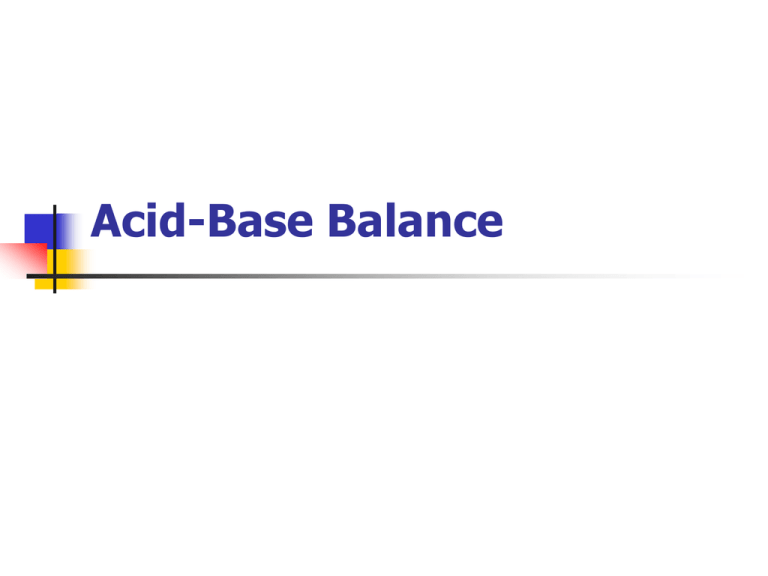Acid-Base Balance
advertisement

Acid-Base Balance Copyright © The McGraw-Hill Companies, Inc. Permission required for reproduction or display. Objectives Explain how the pH of the blood is stabilized by bicarb buffer and define the terms acidosis and alkalosis. Explain how the acid-base balance of the blood is affected by C02 and HC03-, and describe the roles of the lungs and kidneys in maintaining acid-base balance. Explain how C02 affects blood pH, and hypoventilation and hyperventilation affect acid-base balance. Explain how the interaction between plasma K+ and H+ concentrations affects the tubular secretion of these. Copyright © The McGraw-Hill Companies, Inc. Permission required for reproduction or display. pH pH of blood is 7.35 to 7.45 pH = 6.1 + log [HCO3-] 0.03 x Pco2 Copyright © The McGraw-Hill Companies, Inc. Permission required for reproduction or display. Types of Acids in the Body Volatile acids: Can leave solution and enter the atmosphere. H2C03 (carbonic acid). Pco2 is most important factor in pH of body tissues. Copyright © The McGraw-Hill Companies, Inc. Permission required for reproduction or display. Types of Acids in the Body Fixed Acids: Acids that do not leave solution. Sulfuric and phosphoric acid. Catabolism of amino acids, nucleic acids, and phospholipids. Copyright © The McGraw-Hill Companies, Inc. Permission required for reproduction or display. Types of Acids in the Body Organic Acids: Byproducts of aerobic metabolism, during anaerobic metabolism and during starvation, diabetes. Lactic acid, ketones. Copyright © The McGraw-Hill Companies, Inc. Permission required for reproduction or display. Buffer Systems Provide or remove H+ and stabilize the pH. Include weak acids that can donate H+ and weak bases that can absorb H+. Does NOT prevent a pH change. Copyright © The McGraw-Hill Companies, Inc. Permission required for reproduction or display. Chemical Buffers Act within fraction of a second. Protein. HCO3-. Phosphate. Copyright © The McGraw-Hill Companies, Inc. Permission required for reproduction or display. Proteins COOH or NH2. Largest pool of buffers in the body. pk. close to plasma. Albumin, globulins such as Hb. Copyright © The McGraw-Hill Companies, Inc. Permission required for reproduction or display. HCO3 pk. = 6.1. Present in large quantities. Open system. Respiratory and renal systems act on this buffer system. Most important ECF buffer. Copyright © The McGraw-Hill Companies, Inc. Permission required for reproduction or display. HCO3- Limitations Cannot protect ECF from respiratory problems. Cannot protect ECF from elevated or decreased CO2. Limited by availability of HCO3-. Copyright © The McGraw-Hill Companies, Inc. Permission required for reproduction or display. Phosphates pk. = 6.8. Low [ ] in ECF, better buffer in ICF, kidneys, and bone. Copyright © The McGraw-Hill Companies, Inc. Permission required for reproduction or display. Respiratory System 2nd line of defense. Acts within min. maximal in 12-24 hrs. H2CO3 produced converted to CO2, and excreted by the lungs. Alveolar ventilation also increases as pH decreases (rate and depth). Coarse , CANNOT eliminate fixed acid. Copyright © The McGraw-Hill Companies, Inc. Permission required for reproduction or display. Urinary Buffers Nephron cannot produce a urine pH < 4.5. IN order to excrete more H+, the acid must be buffered. H+ secreted into the urine tubule and combines with HPO4-2 or NH3. HPO4-2 + H+ H2PO4-2 NH3 + H+ NH4+ Copyright © The McGraw-Hill Companies, Inc. Permission required for reproduction or display. Renal Acid-Base Regulation Kidneys help regulate blood pH by excreting H+ and reabsorbing HC03-. Most of the H+ secretion occurs across the walls of the PCT in exchange for Na+. Antiport mechanism. Moves Na+ and H+ in opposite directions. Normal urine normally is slightly acidic because the kidneys reabsorb almost all HC03- and excrete H+. Returns blood pH back to normal range. Copyright © The McGraw-Hill Companies, Inc. Permission required for reproduction or display. Reabsorption of HCO3 Apical membranes of tubule cells are impermeable to HCO3-. When urine is acidic, HCO3- combines with H+ to form H2C03-, which is catalyzed by ca located in the apical cell membrane of PCT. Reabsorption is indirect. As [C02] increases in the filtrate, C02 diffuses into tubule cell and forms H2C03. H2C03 dissociates to HCO3- and H+. HCO3- generated within tubule cell diffuses into peritubular capillary. Copyright © The McGraw-Hill Companies, Inc. Permission required for reproduction or display. Acidification of Urine Insert fig. 17.28 Copyright © The McGraw-Hill Companies, Inc. Permission required for reproduction or display. Urinary Buffers Nephron cannot produce a urine pH < 4.5. In order to excrete more H+, the acid must be buffered. H+ secreted into the urine tubule and combines with HPO4-2 or NH3. HPO4-2 + H+ H2PO4NH3 + H+ NH4+ Copyright © The McGraw-Hill Companies, Inc. Permission required for reproduction or display. Metabolic Acidosis Gain of fixed acid or loss of HCO3-. Plasma HCO3- decreases. PCO2 decreases. pH decreases. Copyright © The McGraw-Hill Companies, Inc. Permission required for reproduction or display. Metabolic Alkalosis Loss of fixed acid or gain of HCO3-. Plasma HCO3- increases. PCO2 increases. pH increases. Copyright © The McGraw-Hill Companies, Inc. Permission required for reproduction or display. Respiratory Acidosis PCO2 increases. Plasma HCO3- increases. pH decreases. Copyright © The McGraw-Hill Companies, Inc. Permission required for reproduction or display. Respiratory Alkalosis PCO2 decreases. Plasma HCO3- decreases. pH increases. Copyright © The McGraw-Hill Companies, Inc. Permission required for reproduction or display. Anion Gap The difference between [Na+] and the sum of [HC03-] and [Cl-]. + [Na ] – ([HC03 ] + [Cl ]) = 140 - (24 + 105) = 11 Normal = 12 + 2 Clinicians use the anion gap to identify the cause of metabolic acidosis. Copyright © The McGraw-Hill Companies, Inc. Permission required for reproduction or display. Anion Gap Law of electroneutrality: The major cation is Na+. Blood plasma contains an = number of + and – charges. Minor cations are K+, Ca2+ , Mg2+. The major anions are HC03and Cl-. (Routinely measured.) Minor anions include albumin, phosphate, sulfate (called unmeasured anions). Organic acid anions include lactate and acetoacetate,. Copyright © The McGraw-Hill Companies, Inc. Permission required for reproduction or display. Anion Gap In metabolic acidosis, the strong acid releases protons that are buffered primarily by [HC03]. This causes plasma [HC03-] to decrease, shrinking the [HC03-] on the ionogram. Anions that remain from the strong acid, are added to the plasma. If lactic acid is added, the [lactate] rises. Increasing the total [unmeasured anions]. If HCL is added, the [Cl-] rises. Decreasing the [HC03-]. Copyright © The McGraw-Hill Companies, Inc. Permission required for reproduction or display. Anion Gap in Metabolic Acidosis Salicylates raise the gap to 20. Renal failure raises gap to 25. Diabetic ketoacidosis raises the gap to 35-40. Lactic acidosis raises the gap to > 35 (>50). Largest gaps are caused by ketoacidosis and lactic acidosis.







